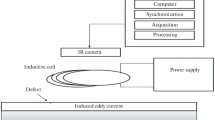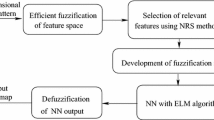Abstract
A fuzzy reasoning based expert system is developed for the recognition of welds in radiographic images. First, each object in a radiographic image is identified and described with a three-feature vector. Of interest are to distinguish welds from non-weld objects in order to extract welds for further processing, such as, flaws detection. To this end, a fuzzy reasoning method is proposed. The fuzzy rules are extracted from feature data one feature at a time based on a modified fuzzy c-means algorithm. The number of fuzzy terms with \(\frac{1}{2}\) overlapping between adjacent terms and the shape of terms are optimized based on the mean squared error criterion. The total number of fuzzy rules is the product of the number of fuzzy terms for each feature. The performance of this optimal set of fuzzy rules is tested with unseen data in terms of accurate rate, false positive rate, and false negative rate. For comparison, selected sets of rules are extracted by varying the number of fuzzy terms for each feature and subsequently tested. The performance of the fuzzy expert system is also found to be better than that of multi-layer perceptron neural networks, if appropriately designed.
Similar content being viewed by others
References
Aoki, L. and Suga, Y. (1999) Application of artificial neural network to discrimination of defect type in automatic radiographic testing of welds. ISIJ International, 39(10), 1081–1087.
Ascia, G., Catania, V., Ficili, G., Palazzo, S. and Panno, D. (1997) AA VLSI fuzzy expert system for real-time traffic control in ATM networks. IEEE Transactions on Fuzzy Systems, 5(1), 20–31.
Bezdek, J. C. (1987) Pattern Recognition with Fuzzy Objective Function Algorithms, Plenum Press, New York and London.
Chang, C. S. and Thia, B. S. (1996) Online rescheduling of mass rapid transit systems: Fuzzy expert system approach. IEE Proceedings—Electric Power Applications, 143(4), 307–316.
Daum, W., Rose, P., Heidt, H. and Builtjes, J. H. (1987) Automatic recognition of weld defects in X-ray inspection. British Journal of NDT, 29(2), 79–82.
Delgado, M., Gomez-Skarmeta, A. F. and Martin, F. (1997) A fuzzy clustering-based rapid prototyping for fuzzy rule-based modeling. IEEE Transactions on Fuzzy Systems, 5(2), 223–232.
Dunn, J. C. (1974) A fuzzy relative of the ISODATA process and its use in detecting compact well-separated clusters. Journal of Cybernetics, 3, 32–57.
Gayer, A., Saya, A. and Shiloh, A. (1990) Automatic recognition of welding defects in real-time radiography. NDT International, 23(3), 131–136.
Graeme, W. A. K., Eizember, A. C. and Douglass, J. (1990) Digital image analysis of nondestructive testing radiographs. Materials Evaluation, February, 117–120.
Gupta, L., Wang, J., Charles, A. and Kisatsky, P. (1994) Three-layer perceptron based classifiers for the partial shape classification problem. Pattern Recognition, 27(1), 91–97.
Hsu, Y. Y. and Ho, K. L. (1992) Fuzzy expert systems An application to short term load forecasting. IEEE Proceedings C—Generation Transmission and Distribution, 139(6), 471–477.
Hyatt, R., Kechter, G. E. and Nagashima, S. (1996) A method for defect segmentation in digital radiographs of pipeline girth welds. Materials Evaluation, August, 925–928.
Josien, K. and Liao, T. W. (2000) Integrated use of fuzzy c-means and fuzzy KNN for GT part family and machine cell formation. International Journal of Production Research, 38(15), 3513–3536.
Kato, Y., Okumura, T., Matsui, S., Itoga, K., Harada, T., Sugimoto, K., Michiba, K., Iuchi, S. and Kawano, S. (1992) Development of an automatic weld defect identification system for radiographic testing. Welding in the World, 30(7/8), 182–188.
Kim, K. H., Park, J. K., Hwang, K. J. and Kim, S. H. (1995) Implementation of hybrid short term load forecasting system using artificial neural networks and fuzzy expert systems. IEEE Transactions on Power Systems, 10(3), 1534–1539.
Konstantinides, K. and Rasure, J. R. (1994) The Khoros software development environment for image and signal processing. IEEE Transactions on Image Processing, 3, 243–252.
Lee, E. T. (1996) Intelligent factories using fuzzy expert systems. Kybernetes, 25(3), 51.
Liao, T. W. (1996) MLP neural network models of CMM measuring processes. Journal of Intelligent Manufacturing, 7, 413–425.
Liao, T. W. and Chen, L. J. (1994) A neural network approach for grinding processes modeling and optimization. International Journal of Machine Tools and Manufacture, 34(7), 919–937.
Liao, T. W. and Chen, L. J. (1998) Manufacturing process modeling and optimization based on multi-layer perceptron networks. ASME Transactions Journal of Manufacturing Science and Engineering, 120(1), 109–119.
Liao, T. W. and Li, Y. M. (1998) An automated radiographic NDT system for weld inspection: Part II flaw detection. NDT&E International, 31(3), 183–192.
Liao, T. W. and Ni, J. (1996) An automated radiographic NDT system for weld inspection: Part I weld extraction. NDT&E International, 29(3), 157–162.
Liao, T. W. and Tang, K. (1997) Automated extraction of welds from digitized radiographic images based on MLP neural networks. Applied Artificial Intelligence, 11(3), 197–218.
Liao, T. W., Li, D.-M. and Li, Y.-M. (1999) Detection of welding flaws from radiographic images with fuzzy clustering methods. Fuzzy Sets and Systems, 108(2), 145–158.
Liao, T. W., Li, D.-M. and Li, Y.-M. (2000) Extraction of welds from radiographic images using fuzzy classifiers. Information Sciences, 126, 21–42.
Liao, T. W., Celmins, A. K. and Hammell, R. J., II 2003. A fuzzy c-means variant for the generation of fuzzy term sets. Fuzzy Sets and Systems, 135(2), 241–257.
Lin, C. K. and Chang, G. L. (1998) Development of a fuzzy expert system for incident detection and classification. Mathematical and Computer Modeling, 17(9–11), 9–25.
Medasani, S., Kim, J. and Krishnapuram, R. (1998) An overview of membership function generation techniques for pattern recognition. International Journal of Approximate Reasoning, 19, 391–417.
Murakami, K. (1990) Image processing for non-destructive testing. Welding International, 4(2), 144–149.
Pal, N. R. and Bezdek, J. C. (1995) On cluster validity for the fuzzy c-means model. IEEE Transactions on Fuzzy Systems, 3(3), 370–379.
Pal, N. R., Pal, P. and Basu, A. K. (1993) A new shape representation scheme and its application to shape discrimination using a neural network. Pattern Recognition, 26(4), 543–551.
Rezaee, M. R., Lelieveldt, B. P. F. and Reiber, J. H. C. (1998) A new cluster validity index for the fuzzy c-means. Pattern Recognition Letters, 19, 237–246.
Windham, M. P. (1982) Cluster validity for the fuzzy c-means clustering algorithm. IEEE Transactions on Pattern Analysis and Machine Intelligence, 4(4), 357–362.
Xie, X. L. and Beni, G. (1991) A validity measure for fuzzy clustering. IEEE Transactions on Pattern Analysis and Machine Intelligence, 13(8), 841–847.
Zahid, N., Limouri, M. and Essaid, A. (1999) A new cluster validity for fuzzy clustering. Pattern Recognition, 32, 1089–1097.
Author information
Authors and Affiliations
Rights and permissions
About this article
Cite this article
Liao, T.W. Fuzzy reasoning based automatic inspection of radiographic welds: weld recognition. Journal of Intelligent Manufacturing 15, 69–85 (2004). https://doi.org/10.1023/B:JIMS.0000010076.56537.07
Issue Date:
DOI: https://doi.org/10.1023/B:JIMS.0000010076.56537.07




